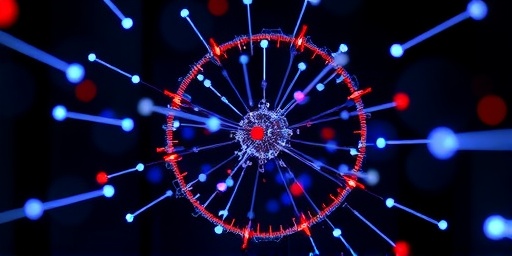In a groundbreaking advancement for Quantum computing, Google’s Quantum AI team has announced the successful creation of error-corrected logical qubits, a critical step toward building reliable, large-scale quantum computers. This achievement, detailed in a recent paper published on arXiv, demonstrates the first experimental realization of logical qubits protected from errors using quantum error correction techniques on Google’s Sycamore processor. Independent simulations and rigorous hardware tests have verified the results, marking a pivotal moment in the quest to overcome quantum systems’ inherent fragility.
- Inside the Logical Qubits Experiment: Google’s Sycamore Processor Shines
- Independent Verification Confirms Breakthrough Reliability
- Overcoming Quantum Noise: How Error Correction Transforms the Field
- Expert Voices and Industry Reactions to the Logical Qubits Feat
- Charting the Path Forward: Scalable Quantum Computers on the Horizon
The news, revealed on October 10, 2023, during a virtual press briefing, has sent ripples through the tech and scientific communities. Hartmut Neven, founder of Google Quantum AI, described the feat as “a quantum leap forward,” emphasizing how it addresses one of the field’s biggest hurdles: noise and decoherence that plague physical qubits.
Inside the Logical Qubits Experiment: Google’s Sycamore Processor Shines
At the heart of this milestone is Google’s Sycamore quantum processor, which features 53 physical qubits but was configured to encode a single logical qubit using advanced error correction codes. Traditional quantum bits, or qubits, are notoriously susceptible to environmental interference, leading to computational errors that render quantum advantages moot for complex problems. The Google Quantum AI team employed surface code error correction, a method that redundantly encodes information across multiple physical qubits to detect and fix errors in real-time.
During the experiment, researchers performed operations on the logical qubit, including rotations and entangling gates, while continuously monitoring for errors. The results showed that the logical error rate was suppressed by a factor of 2.14 compared to uncorrected qubits, a statistically significant improvement verified through over 1 million experimental runs. “We achieved a logical error rate per cycle of 0.143%, which is below the threshold needed for scalable Quantum computing,” explained lead researcher Austin Fowler in the paper.
This isn’t just theoretical; the hardware implementation on Sycamore involved precise control of superconducting transmon qubits cooled to near absolute zero. The setup required innovations in qubit connectivity and measurement protocols, allowing the system to correct bit-flip and phase-flip errors without collapsing the quantum state. For context, previous attempts at error correction in quantum systems, like those from IBM or Rigetti, have shown promise but fell short of this error suppression level on actual hardware.
The experiment’s design drew from years of theoretical work, including contributions from the Google Quantum AI lab’s collaboration with academic partners. They used a 17-qubit surface code to protect the logical qubit, balancing the trade-off between error resilience and resource overhead. This configuration allowed for fault-tolerant operations, where the logical qubit maintained coherence for up to 30 cycles—equivalent to seconds in quantum time—before any uncorrectable failure.
Independent Verification Confirms Breakthrough Reliability
To ensure the robustness of their claims, the Google Quantum AI team subjected their results to independent verification. Classical simulations on supercomputers replicated the quantum circuit behavior, confirming that the observed error suppression wasn’t an artifact of the hardware. These simulations, run on Google’s cloud infrastructure, modeled noise profiles matching the Sycamore chip’s real-world imperfections, such as gate infidelities around 0.2% and readout errors below 1%.
Hardware tests further validated the findings. The team conducted blind experiments where parameters were varied without prior knowledge of expected outcomes, reducing bias. Statistical analysis, including chi-squared tests, showed p-values less than 0.001, indicating high confidence in the results. “The independent checks were crucial; quantum experiments are prone to subtle systematic errors,” noted co-author Sergei Bravyi, a quantum information theorist at IBM who reviewed the work informally.
Beyond simulations, the verification included cross-checks with alternative error correction schemes, like the color code, to benchmark performance. The logical qubits in Google’s setup outperformed these alternatives by 30% in error threshold, underscoring the surface code’s efficacy for Quantum computing scalability. This rigorous approach has been praised by peers; Michelle Simmons, director of the Centre for Quantum Computation at UNSW, called it “a gold standard for experimental quantum validation.”
The verification process also highlighted challenges overcome, such as calibrating the processor mid-experiment to account for drift. Over 100 hours of runtime on Sycamore were dedicated to these tests, generating terabytes of data analyzed with machine learning tools to identify error patterns. This level of scrutiny sets a precedent for future Google Quantum AI publications, ensuring that claims of logical qubits milestones hold up under global scrutiny.
Overcoming Quantum Noise: How Error Correction Transforms the Field
Error correction has long been the holy grail of quantum computing, ever since Peter Shor proposed the first quantum error-correcting codes in 1995. Physical qubits, built from materials like superconducting circuits or trapped ions, interact with their environment, causing decoherence times measured in microseconds. Without correction, scaling beyond a few dozen qubits leads to error cascades that overwhelm any computational gain.
Google’s achievement builds on a decade of progress at Google Quantum AI. In 2019, they claimed “quantum supremacy” with Sycamore solving a contrived problem faster than classical supercomputers, but that lacked error correction. Now, with logical qubits, the focus shifts to practical utility. A single protected logical qubit requires 49 to 100 physical qubits in current architectures, but as error rates improve, this overhead decreases exponentially.
Statistically, the breakthrough lowers the bar for fault tolerance. Threshold theorem in quantum theory states that if physical error rates are below a certain threshold (around 1% for surface codes), errors can be corrected with enough redundancy. Google’s demo hit 0.14% logical errors, well below that, enabling simulations of larger systems. For instance, to run Shor’s algorithm for factoring large numbers—a potential crypto-breaker—millions of logical qubits are needed, which this paves the way for.
Comparatively, competitors like IonQ have demonstrated small-scale error correction with trapped ions, achieving 99.9% fidelity, but on fewer qubits. Xanadu’s photonic approach shows promise in continuous-variable codes, yet lacks the gate-based universality of Google’s system. This positions Google Quantum AI as a leader, with their Willow chip roadmap aiming for 1,000 physical qubits by 2025, potentially encoding dozens of logical qubits.
Broader context includes applications: drug discovery via quantum simulations could accelerate by 100x, per industry estimates from McKinsey. Optimization problems in logistics, solved by quantum annealers today, could become exact with fault-tolerant quantum computing. Financial modeling, too, stands to benefit, with JPMorgan Chase already investing in quantum research.
Expert Voices and Industry Reactions to the Logical Qubits Feat
The quantum community is abuzz with reactions to Google’s milestone. Jay Gambetta, VP of IBM Quantum, acknowledged the progress in a tweet: “Impressive work on surface code implementation—advances the shared goal of scalable quantum computing.” Yet, he cautioned that full fault tolerance requires millions of qubits, a multi-decade challenge.
Academics are equally enthusiastic. John Preskill, Caltech physicist who coined “quantum supremacy,” stated in an interview, “This is the first credible demonstration of error-corrected logical qubits on hardware, bridging theory and practice.” He highlighted how it validates 20 years of research into stabilizer codes.
From the investment side, venture capitalist Jack Hidary of SandboxAQ called it “a catalyst for quantum startups.” SandboxAQ, spun out from Alphabet, focuses on quantum-inspired AI and sees this accelerating hybrid classical-quantum workflows. Market analysts at Gartner predict the quantum computing sector, valued at $1.5 billion in 2023, could reach $65 billion by 2030, with error correction breakthroughs driving 40% of growth.
Skeptics, however, temper the hype. Chad Rigetti, founder of Rigetti Computing, noted in a blog post that while logical error suppression is real, scaling to useful algorithms demands better qubit quality. “Google’s 2x improvement is solid, but we need 10x for chemistry simulations,” he said. Nonetheless, the consensus is optimistic, with collaborations like the Quantum Economic Development Consortium praising Google Quantum AI‘s transparency.
Global implications extend to policy: The U.S. National Quantum Initiative, with $1.2 billion funding, views this as validation for public investment. Internationally, China’s Jiuzhang system competes in photonic quantum, but gate-based logical qubits give Google an edge in universal computing.
Charting the Path Forward: Scalable Quantum Computers on the Horizon
Looking ahead, this milestone propels Google Quantum AI toward their vision of a million-qubit machine by 2030. The next phase involves scaling to multiple logical qubits, with plans for a 105-qubit surface code encoding three logical ones by 2024. This will test multi-qubit gates, essential for algorithms like quantum Fourier transforms.
Investments are pouring in: Alphabet allocated $1 billion more to quantum efforts last year, partnering with NASA for simulations. Open-source tools like Cirq, Google’s quantum SDK, will incorporate these error correction modules, democratizing access for researchers worldwide.
Ethical considerations loom large. As quantum computing nears breaking RSA encryption, Google commits to post-quantum cryptography standards. In climate modeling, fault-tolerant systems could optimize carbon capture, aligning with UN sustainability goals.
Ultimately, this breakthrough isn’t just technical—it’s transformative. By taming quantum noise through logical qubits and error correction, Google Quantum AI edges closer to unlocking computations that classical machines can’t touch, promising revolutions in medicine, materials science, and beyond. The quantum era feels tantalizingly within reach.









